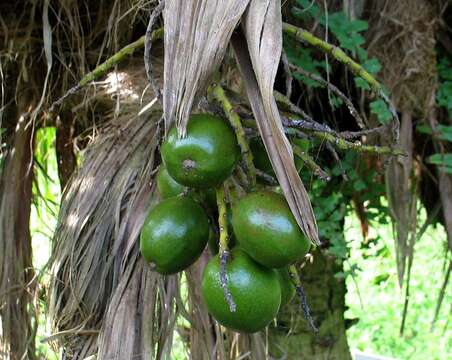Pritchardia hillebrandii

Descrição:
Loulu lelo or Hillebrand's pritchardiaArecaceae (Palm family)Endemic to the Hawaiian Islands (Restricted to the offshore islets of Huelo & Mkapu on the north coast of Molokai)RareOahu (Cultivated)Loulu, pronounced low-loo, means "umbrella," because the leaves were formerly used as protection from rain or sun.The fruits, called hwane or whane, were peeled and eaten by early Hawaiians. They collected young fruits. The flavor of young fruit with the soft interior is similar to coconut. The trunks loulu were notched for climbing to gather the immature fruits and fronds. Older specimens still bear notches that can be seen today.The fronds, or leaves, called lau hwane were used by the early Hawaiians for thatching and more recently as plaiting such as papale (hats) and fans.EtymologyThe generic name is named for William Thomas Pritchard (1829-1907), 19th century British Counsul in Fiji, adventurer, and author of Polynesian Reminiscences in 1866.The specific epithet hillebrandii was named for William Hillebrand (1821-1886), a young Prussian physician and plant collector. He planted many of the plants he collected at Queen's Hospital and on his own property in Nuuanu. After moving back to Germany the property was sold to his neighbors Thomas & Mary Foster. Today, it is known as the Foster Botanical Gardens. There are several Pritchardia hillebrandii growing in the gardens, once Hillebrand's property.NPH00007nativeplants.hawaii.edu/plant/view/Pritchardia_hillebrandii
Incluído nas seguintes páginas:
- Life
- Cellular
- Eukaryota (Eucariontes)
- Archaeplastida
- Chloroplastida
- Streptophyta
- Embryophytes
- Tracheophyta
- Spermatophytes (Spermatophyta)
- Angiosperms
- Monocots
- Commelinids
- Arecales
- Arecaceae (palmeira)
- Pritchardia
- Pritchardia hillebrandii
Esta imagem não aparece em nenhuma coleção.
Informação de origem
- licença
- cc-by
- direitos autorais
- David Eickhoff
- fotógrafo
- David Eickhoff
- original
- arquivo de mídia original
- visite a fonte
- site do parceiro
- Flickr Group
- ID


